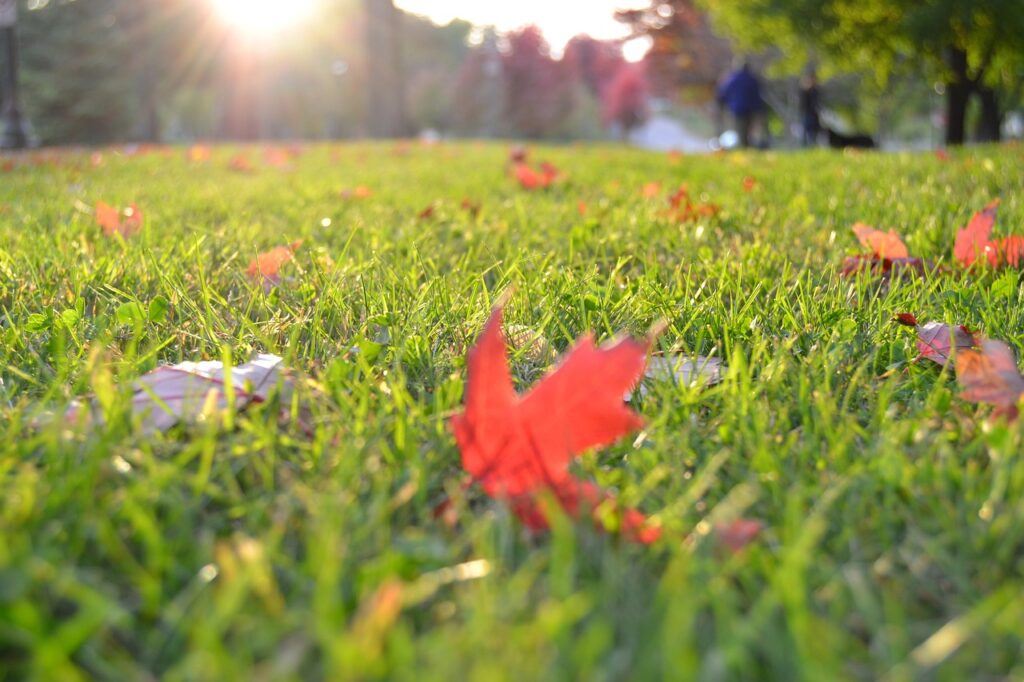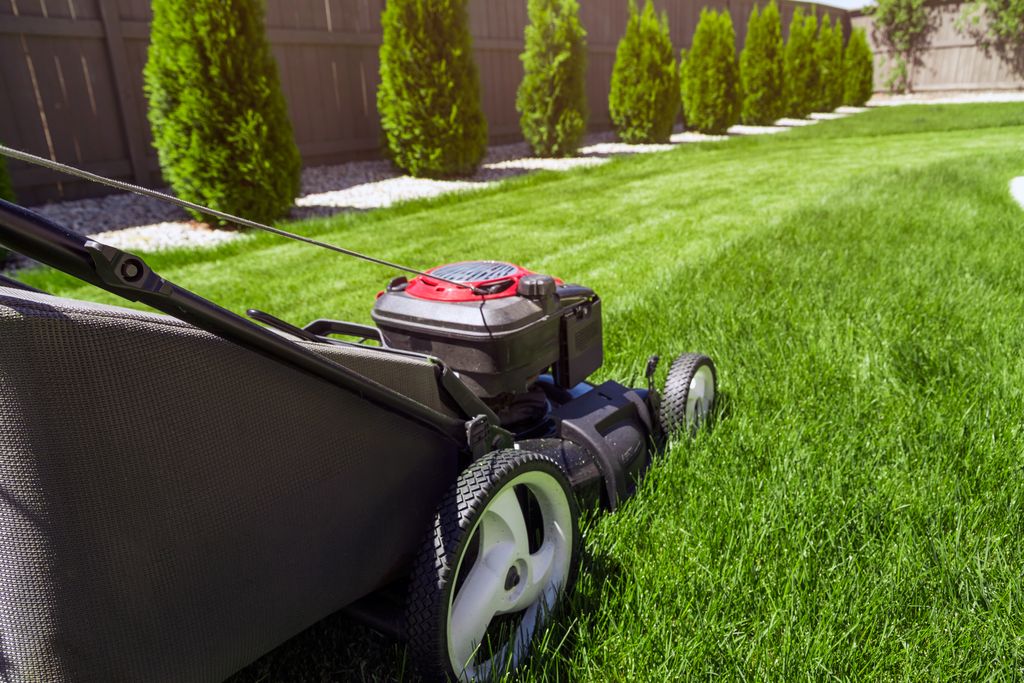As the crisp autumn air began to settle in, I found myself standing in my yard, marveling at the vibrant hues of orange and gold.
I remember my neighbor, a seasoned gardener, sharing his fall lawn care secrets tailored to our temperate climate, which made all the difference in keeping our grass lush through winter.
With a few simple adjustments, like aerating and overseeding, I felt empowered to nurture my lawn while enjoying the beautiful seasonal change around me.
This post contains affiliate links. As an Amazon Associate, I earn from qualifying purchases at no additional cost to you.
Understanding Fall Lawn Care for Cool Climate Regions
As the days get shorter and temperatures drop in cool climate regions, homeowners face unique challenges in maintaining their lawns.
Frost can sneak in, often catching us off guard, and shorter growing seasons mean that every lawn care decision counts.
Grass Types for Cooler Climates
When it comes to choosing the right grass, cool-season grasses thrive in these environments.
Here are some top contenders and their maintenance tips:
| Grass Type | Characteristics | Maintenance Needs |
|---|---|---|
| Kentucky Bluegrass | Dense, lush, and drought-resistant | Regular watering and fertilizing in early fall |
| Perennial Ryegrass | Quick germination and establishment | Mow regularly to encourage growth |
| Fine Fescue | Ideal for shady areas | Minimal watering; keep it on the shorter side |
Pro Tips:
To prepare your lawn for winter, focus on aerating and overseeding in the fall. This helps ensure your grass is robust enough to withstand frost.
Whether you’re dealing with a frost-resistant grass or fine fescue, a well-timed feeding can also promote healthier growth. If you’re unsure where to start, consider consulting with a local lawn care specialist for tailored advice specific to your region.
Essential Fall Lawn Care for Transitional Climate Areas
Overseeding and Fertilization
In transitional climate areas, overseeding is a crucial step in preparing your lawn for the winter months.
By adding new grass seed, you can ensure that your lawn remains thick and healthy, combating any thinning that may have occurred during the summer heat.
Fertilization supports this process by providing essential nutrients to both the existing grass and the newly seeded areas.
This combination boosts root development, allowing your lawn to withstand the colder temperatures ahead.
Optimal Watering Practices
As the temperatures begin to fluctuate in fall, proper watering is essential to prevent drought stress.
It’s important to maintain consistent moisture levels, especially after overseeding.
Aim to water early in the morning when temperatures are cooler, allowing the grass to absorb moisture before the heat of the day kicks in.
Here’s a quick guideline for watering:
| Time of Day | Duration | Frequency |
|---|---|---|
| Early Morning | 30 minutes | 2-3 times per week |
Pro Tips:
Monitor the weather conditions closely in fall. A few cool, sunny days can dry out your lawn quickly, so adjust your watering schedule accordingly. Remember to apply a winterization fertilizer a few weeks before the first frost to prepare your lawn for the cold months ahead.
Essential Fall Lawn Care Techniques for Warm Climates
Maintaining a healthy lawn in warm climates during the fall is vital for a lush spring.
Here are some techniques that have worked wonders for me and my neighbors.
Mowing Tips
- Mow higher: Keep your grass at about 3 to 4 inches. Taller grass helps retain moisture and shade the soil, preventing weeds.
- Frequency: Mow every 1 to 2 weeks, adjusting as growth slows.
Fertilization
Choose the right fertilizer: Opt for a slow-release fertilizer that’s high in nitrogen. This boosts growth and prepares your lawn for winter.
| Type of Fertilizer | N-P-K Ratio |
|---|---|
| Slow-Release | 20-5-10 |
| Organic | 10-2-8 |
Aeration
- Aerate your lawn: This process allows air, water, and nutrients to penetrate the soil. Use a core aerator to remove small plugs of soil.
Watering
- Water your lawn deeply but infrequently: Try to give it about 1 inch of water once a week. For example, a simple rain gauge can help track rainfall and adjust your watering schedule accordingly.
Overseeding
- Consider overseeding: This helps thicken your lawn and fills in any bare spots. Use a grass variety suited for your area.
Pest Management in Fall Lawn Care Across Various Climates
Common Fall Pests and Diseases
As the leaves turn and temperatures drop, your lawn faces threats from various pests and diseases.
Here are some common culprits to watch out for:
| Pest/Disease | Description | Management |
|---|---|---|
| Grubs | Larvae of beetles; damage roots. | Treat with grub control products. |
| Armyworms | Caterpillars that consume grass. | Apply insecticides early on. |
| Dollar Spot | Fungal disease causing brown patches. | Improve lawn drainage; use fungicides. |
| Brown Patch | Another fungal issue, especially in humid areas. | Mow high and water early in the day. |
Importance of Preventative Measures
Preventative measures are key to ensuring your lawn remains healthy through winter.
Here are some strategies to consider:
- Aerate your lawn: This helps roots absorb nutrients and water better.
- Fertilize: A good fall fertilizer promotes strong growth and resilience against pests.
- Mow properly: Keep grass at a height of 2.5 to 3 inches to prevent pests from settling in.
Pro Tips: Always keep an eye out for signs of pests, such as uneven grass growth or unusual patches. Implementing these preventative measures not only protects your lawn but sets the stage for a green, vibrant yard come spring.
The Role of Fertilization in Fall Lawn Care Strategies
When fall arrives, it’s the perfect time to focus on your lawn’s health, and fertilization plays a vital role.
Applying a slow-release fertilizer nourishes your lawn, giving it essential nutrients to help it thrive through winter dormancy.
This method allows your grass to absorb nutrients gradually, promoting root development and resilience against cold temperatures.
Benefits of Slow-Release Fertilizer
- Sustained Nutrition: Provides a steady supply of nutrients.
- Enhanced Root Growth: Helps roots develop deeper for better water and nutrient access.
- Winter Resilience: Prepares your lawn to withstand harsh winter conditions.
Pro Tips: Always choose a fertilizer that’s specifically designed for fall application. Look for one with a higher percentage of potassium, as it helps build stress tolerance.
Soil Testing Benefits
- Custom Nutrient Plan: Identifies deficiencies and excesses.
- Climate Adaptability: Adjusts applications based on regional needs.
Fall Lawn Care Practices for Soil Health Improvement
Aeration Benefits
Aerating your lawn is a game-changer when it comes to relieving soil compaction and improving water infiltration.
With the summer heat behind us, the fall season is the perfect time to give your lawn some much-needed attention.
Aeration involves perforating the soil with holes, allowing air, water, and nutrients to penetrate deep into the root zone.
This process not only enhances root growth but also helps create a healthier lawn overall.
Topdressing with Compost
Another powerful practice for improving soil health is topdressing with compost.
Spreading a thin layer of organic compost over your lawn enhances soil structure and boosts nutrient content.
This is particularly effective in the fall when the ground is still warm, allowing beneficial microorganisms to thrive.
Your grass will thank you by becoming greener and more resilient to winter stress.
Pro Tips: Consider combining aeration and topdressing for maximum benefits. After aerating, apply a layer of compost to ensure your lawn gets the nutrients it needs as it prepares for the colder months. This one-two punch will set you up for a lush lawn come spring!
Watering Considerations in Fall Lawn Care
As temperatures drop and rainfall increases, it’s essential to adjust your irrigation schedules accordingly.
Here’s a handy outline to help you manage your watering routine effectively:
| Temperature Range | Irrigation Frequency | Recommended Duration |
|---|---|---|
| Above 65°F | Twice a week | 30 minutes each time |
| 50°F – 64°F | Once a week | 45 minutes |
| Below 50°F | No watering required | — |
Deep watering is crucial during fall lawn care. It encourages roots to grow deeper, preparing your lawn to withstand harsh winter conditions.
Aim to water your lawn to a depth of about 6-8 inches, which promotes a robust root system and helps your grass survive the colder months.
Pro Tips:
- Invest in a soil moisture gauge to check when your lawn truly needs watering. This can help prevent overwatering, which can lead to other problems like mold or disease.
- Consider watering in the early morning or late afternoon when temperatures are cooler to minimize evaporation.
Remember, a well-watered lawn in the fall will set the stage for a lush, green comeback in spring!
Final Thoughts
As we’ve explored, fall lawn care varies across climates, but the core principles remain the same: understand your grass type, implement effective overseeding and fertilization practices, and stay vigilant against pests.
By aerating your lawn, adjusting watering schedules, and using slow-release fertilizers, you set the groundwork for a healthy, resilient yard that can withstand winter’s chill.
So, don’t let the seasonal changes catch you off guard—take charge of your lawn care now!
F.A.Q
What are the key steps for fall lawn care in warm climates?
In warm climates, focus on overseeding and fertilizing your lawn in the fall. Choose a suitable grass type that thrives in heat, and ensure proper watering to promote growth during cooler weather.
How can I adjust my lawn care routine for cold climates in the fall?
In cold climates, it’s important to prepare your lawn for winter. Rake up leaves, aerate the soil, and apply winter fertilizer to help your grass stay healthy. Consider overseeding with cool-season grass for added resilience.
What specific tips should I follow for maintaining grass in dry climates during autumn?
For dry climates, prioritize deep watering and apply mulch to retain moisture. Fall is a great time to plant drought-resistant grass types. Regularly check for any weeds and manage them effectively to keep your lawn healthy.
Are there seasonal adjustments needed for coastal climates in fall lawn care?
Yes! In coastal areas, you should focus on salt tolerance for your grass. Use fertilizers that help fight off salt damage, and ensure proper drainage to avoid waterlogging. Aeration can also help improve the health of sandy soils.
How can I ensure a lush lawn this autumn regardless of my climate?
No matter your climate, the basics of fall lawn care include mowing at the right height, aerating your lawn, and applying appropriate fertilizers. Tailor these practices to suit your specific environment for the best results.



